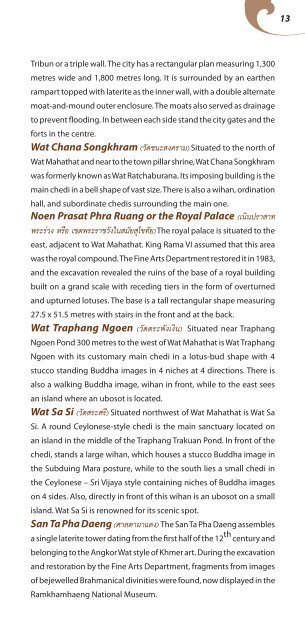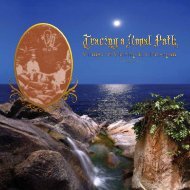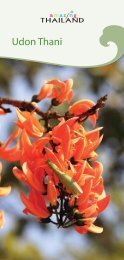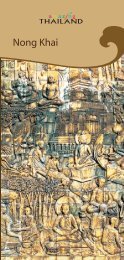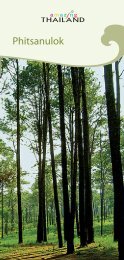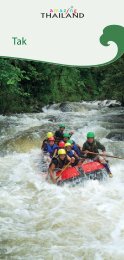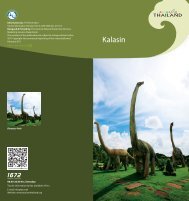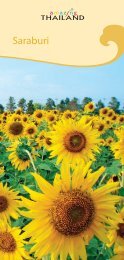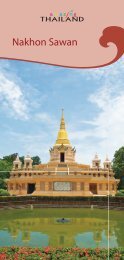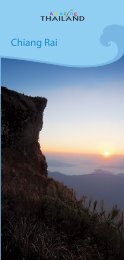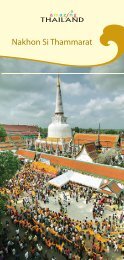Sukhothai - TourismThailand.org - Tourism Authority of Thailand
Sukhothai - TourismThailand.org - Tourism Authority of Thailand
Sukhothai - TourismThailand.org - Tourism Authority of Thailand
You also want an ePaper? Increase the reach of your titles
YUMPU automatically turns print PDFs into web optimized ePapers that Google loves.
Tribun or a triple wall. The city has a rectangular plan measuring 1,300<br />
metres wide and 1,800 metres long. It is surrounded by an earthen<br />
rampart topped with laterite as the inner wall, with a double alternate<br />
moat-and-mound outer enclosure. The moats also served as drainage<br />
to prevent �ooding. In between each side stand the city gates and the<br />
forts in the centre.<br />
Wat Chana Songkhram �������������� Situated to the north <strong>of</strong><br />
Wat Mahathat and near to the town pillar shrine, Wat Chana Songkhram<br />
was formerly known as Wat Ratchaburana. Its imposing building is the<br />
main chedi in a bell shape <strong>of</strong> vast size. There is also a wihan, ordination<br />
hall, and subordinate chedis surrounding the main one.<br />
Noen Prasat Phra Ruang or the Royal Palace������������<br />
��������������������������������������� The royal palace is situated to the<br />
east, adjacent to Wat Mahathat. King Rama VI assumed that this area<br />
was the royal compound. The Fine Arts Department restored it in 1983,<br />
and the excavation revealed the ruins <strong>of</strong> the base <strong>of</strong> a royal building<br />
built on a grand scale with receding tiers in the form <strong>of</strong> overturned<br />
and upturned lotuses. The base is a tall rectangular shape measuring<br />
27.5 x 51.5 metres with stairs in the front and at the back.<br />
Wat Traphang Ngoen ���������������� Situated near Traphang<br />
Ngoen Pond 300 metres to the west <strong>of</strong> Wat Mahathat is Wat Traphang<br />
Ngoen with its customary main chedi in a lotus-bud shape with 4<br />
stucco standing Buddha images in 4 niches at 4 directions. There is<br />
also a walking Buddha image, wihan in front, while to the east sees<br />
an island where an ubosot is located.<br />
Wat Sa Si ����������� Situated northwest <strong>of</strong> Wat Mahathat is Wat Sa<br />
Si. A round Ceylonese-style chedi is the main sanctuary located on<br />
an island in the middle <strong>of</strong> the Traphang Trakuan Pond. In front <strong>of</strong> the<br />
chedi, stands a large wihan, which houses a stucco Buddha image in<br />
the Subduing Mara posture, while to the south lies a small chedi in<br />
the Ceylonese – Sri Vijaya style containing niches <strong>of</strong> Buddha images<br />
on 4 sides. Also, directly in front <strong>of</strong> this wihan is an ubosot on a small<br />
island. Wat Sa Si is renowned for its scenic spot.<br />
San Ta Pha Daeng��������������The San Ta Pha Daeng assembles<br />
a single laterite tower dating from the �rst half <strong>of</strong> the 12 th century and<br />
belonging to the Angkor Wat style <strong>of</strong> Khmer art. During the excavation<br />
and restoration by the Fine Arts Department, fragments from images<br />
<strong>of</strong> bejewelled Brahmanical divinities were found, now displayed in the<br />
Ramkhamhaeng National Museum.<br />
13


